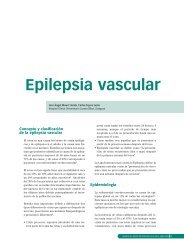epilepsia refractaria - Grupo de Epilepsia de la SEN
epilepsia refractaria - Grupo de Epilepsia de la SEN
epilepsia refractaria - Grupo de Epilepsia de la SEN
Create successful ePaper yourself
Turn your PDF publications into a flip-book with our unique Google optimized e-Paper software.
Cuándo consi<strong>de</strong>rar una <strong>epilepsia</strong> <strong>refractaria</strong> blican un estudio observacional en Neurology sobreel seguimiento <strong>de</strong> un grupo amplio <strong>de</strong> 2.200 pacientes,con eda<strong>de</strong>s comprendidas entre uno y siete años,consiguiendo el control completo <strong>de</strong> sus manifestacionescríticas en el 82% <strong>de</strong> <strong>epilepsia</strong>s generalizadasidiopáticas, en el 35% <strong>de</strong> <strong>epilepsia</strong>s parciales sintomáticasy en el 45% <strong>de</strong> <strong>epilepsia</strong>s parciales criptogénicas.Estos mismos autores <strong>de</strong>muestran que <strong>la</strong> <strong>epilepsia</strong><strong>de</strong>l lóbulo temporal fue <strong>la</strong> más <strong>refractaria</strong> <strong>de</strong><strong>la</strong>s <strong>epilepsia</strong>s parciales, pudiéndose contro<strong>la</strong>r únicamenteel 11% <strong>de</strong> <strong>la</strong>s <strong>epilepsia</strong>s secundarias a una esclerosis<strong>de</strong>l hipocampo y sólo un 20% <strong>de</strong>l total <strong>de</strong> <strong>la</strong>s<strong>epilepsia</strong>s temporales. El porcentaje <strong>de</strong> control <strong>de</strong> <strong>la</strong>s<strong>epilepsia</strong>s extratemporales ascendía a un 36%, aunqueno se encontraron diferencias significativas entre<strong>la</strong>s <strong>epilepsia</strong>s temporales sin esclerosis <strong>de</strong> hipocampoy <strong>la</strong>s <strong>epilepsia</strong>s extratemporales.De forma clásica, conocemos que en pacientes con<strong>epilepsia</strong>s re<strong>la</strong>cionadas con <strong>la</strong> localización, (principalmenteen <strong>la</strong>s secundarias a una esclerosis <strong>de</strong>hipocampo, <strong>la</strong>s malformaciones <strong>de</strong>l <strong>de</strong>sarrollo corticaly los tumores neurogliales) presentan más riesgo<strong>de</strong> ser farmacorresistentes que <strong>la</strong>s <strong>epilepsia</strong>sidiopáticas, al igual que <strong>la</strong> presencia <strong>de</strong> varios tipos<strong>de</strong> crisis predice un peor pronóstico en adultos yniños. Las crisis sintomáticas remotas han sido asociadasa un peor pronóstico 21 <strong>de</strong> forma consistente.La hipoxia perinatal o <strong>la</strong>s agresiones intracranealesque provocan crisis neonatales pue<strong>de</strong>n provocar<strong>epilepsia</strong> en eda<strong>de</strong>s tardías en alre<strong>de</strong>dor <strong>de</strong>l 30% <strong>de</strong>niños. La <strong>epilepsia</strong> postraumática, por su parte, sesuele asociar con un mal pronóstico, consiguiéndoseel control <strong>de</strong> crisis sólo en un tercio <strong>de</strong> los pacientes,a diferencia <strong>de</strong> <strong>la</strong> <strong>epilepsia</strong> vascu<strong>la</strong>r, en <strong>la</strong> quese contro<strong>la</strong>n alre<strong>de</strong>dor <strong>de</strong> los dos tercios <strong>de</strong> lospacientes, lo que nos va a indicar que <strong>la</strong> naturaleza<strong>de</strong>l insulto va a condicionar el pronóstico.Por su parte, el electroencefalograma aporta, para <strong>la</strong>valoración <strong>de</strong> <strong>la</strong> probabilidad <strong>de</strong> una <strong>epilepsia</strong> potencialmente<strong>refractaria</strong>, <strong>la</strong> presencia <strong>de</strong> actividad epileptiformemultifocal y un enlentecimiento <strong>de</strong>l trazado,que suelen asociarse a un peor control <strong>de</strong> <strong>la</strong>s crisis.Por último, está igualmente contrastado que <strong>la</strong> respuestaal primer fármaco antiepiléptico es el mayorpredictor <strong>de</strong>l pronóstico a <strong>la</strong>rgo p<strong>la</strong>zo <strong>de</strong> <strong>de</strong>terminadotipo <strong>de</strong> <strong>epilepsia</strong>, que una historia familiar <strong>de</strong> <strong>epilepsia</strong>suele estar asociada con un peor pronósticotanto en niños como en <strong>la</strong> edad adulta y que <strong>la</strong> presencia<strong>de</strong> déficit neurológicos en los niños, especialmenteen aquéllos que se encuentran asociados conretraso mental, es indicativo <strong>de</strong> un peor pronóstico.Bibliografía1. Nilsen KE, Cock HR. Focal treatment for refractory epilepsy: hopefor the future? Brain Res Rev. 2004; 44: 141-53.2. Boison D. Cell and Gene Therapies for Refractory Epilepsy. CurrentNeuropharmacology, 2007; 5: 115-25.3. Kwan P, Brodie MJ. Early i<strong>de</strong>ntification of refractory epilepsy. NEngl J Med. 2000; 342: 314-9.4. Kwan P, San<strong>de</strong>r JW. The natural history of epilepsy: an epi<strong>de</strong>miologicalview. J Neurol Neurosurg Psychiatry. 2004; 75: 1376-81.5. Arroyo S, Brodie MJ, Avanzini G, Baumgartner C, Chiron C, Du<strong>la</strong>c O,et al. Is refractory epilepsy preventable? <strong>Epilepsia</strong>. 2002; 43: 437-44.6. Gómez Alonso J, Girál<strong>de</strong>z BG. <strong>Epilepsia</strong>: una nueva <strong>de</strong>finición parauna vieja enfermedad. Rev Neurol. 2007; 45: 126-7.7. Scheepers B, Clough P, Pickles C. The misdiagnosis of epilepsy: findingsof a popu<strong>la</strong>tion study. Seizure. 1998; 7(5): 403-6.8. Kuyk J, Leijten F, Meinardi H, Spinhoven, Van Dyck R. The diagnosis ofPsychogenic non-epileptic seizures: a review. Seizure. 1997; 6: 243-53.9. Velis D, Plonin P, Gotman J, da Silva FL, et al. Recomendationsregarding the requirements and applications for long term recordingin epilepsy. <strong>Epilepsia</strong>. 2007; 48(2): 379-84.10. Sánchez Álvarez JC, Serrano Castro P, Cañadil<strong>la</strong>s Hidalgo F.<strong>Epilepsia</strong> <strong>refractaria</strong> <strong>de</strong>l adulto. Rev Neurol. 2002; 35: 931-53.11. Proposal for revised c<strong>la</strong>ssification of epilepsies and epilepticsyndromes. Commission on C<strong>la</strong>ssification and Terminology of theInternational League Against Epilepsy. <strong>Epilepsia</strong>. 1989; 30: 389-99.12. Engel J Jr. A proposed diagnostic scheme for people with epilepticseizures and with epilepsy: report of the ILAE Task Force onC<strong>la</strong>ssification and Terminology. <strong>Epilepsia</strong>. 2001; 42: 796-803.13. Engel J Jr. Intractable epilepsy: <strong>de</strong>finition and neurobiology. <strong>Epilepsia</strong>.2001; 42(Suppl 6): S3.14. Berg AT, Kelly MM. Defining intractability: comparisons amongpublished <strong>de</strong>finitions. <strong>Epilepsia</strong>. 2006; 47: 431-6.15. Mohanraj R, Brodie MJ. Diagnosing refractory epielpsy: response tosequential treatment schedules. Eur J Neurol. 2006; 13(3): 277-82.16. Jallon P. The problem of intractability:the continuing need for newmedical therapies in epilepsy. <strong>Epilepsia</strong>. 1997; 38(Suppl 9): S37-S42.17. Hakimi AS, Spanaki MV, Schuh LA, Smith BJ, Schultz L. A survey ofneurologists' views on epilepsy surgery and medically refractoryepilepsy. Epilepsy Behav. 2008; 13(1): 96-101.18. Jones MW, An<strong>de</strong>rmann F. Temporal lobe epilepsy surgery: <strong>de</strong>finitionof candidacy: Can J Neurol Sci. 2000; 27(Suppl 1): S11-S13.19. Rufo Campos M, Sancho Rieger J, Peña P, Masramón X, RejasGutiérrez J. En nombre <strong>de</strong>l grupo <strong>de</strong> co<strong>la</strong>boradores <strong>de</strong>l estudio LIN-CE. Pautas terapéuticas en el paciente con <strong>epilepsia</strong> farmacorresistenteen consultas ambu<strong>la</strong>torias <strong>de</strong> neurología y <strong>epilepsia</strong> enEspaña. Rev Neurol. 2008; 47 (En prensa).20. Semah F, Picot MC, Adam C, Broglin D, Arzimanoglou A, Bazin B,et al. Is the un<strong>de</strong>rlying cause of epilepsy a major prognostic factorfor recurrence? Neurology. 1998; 51(5): 1256-62.21. Arts WF, Brouwner OF, Peters AC, Stroink H, Peeters EA, SchmitzPI, et al. Course and prognosis of childhood epilepsy: 5-yearfollow-up of the Dutch study of epilepsy in childhood. Brain. 2004;127(Pt 8): 1774-84.REVISTA DEL GRUPO DE EPILEPSIA DE LA <strong>SEN</strong> • ENERO 2009 13



![[ ] POLITERAPIA CON FÃRMACOS ANTIEPILÃPTICOS - Grupo de ...](https://img.yumpu.com/50274055/1/186x260/-politerapia-con-farmacos-antiepilapticos-grupo-de-.jpg?quality=85)
![[ ] OTRAS MEDIDAS DE TRATAMIENTO NO FARMACOLÃGICO ...](https://img.yumpu.com/45080555/1/186x260/-otras-medidas-de-tratamiento-no-farmacolagico-.jpg?quality=85)
![[ ] ACTITUD TERAPÃUTICA EN EL NIÃO Introducción Selección del ...](https://img.yumpu.com/44424278/1/186x260/-actitud-terapautica-en-el-niao-introduccian-seleccian-del-.jpg?quality=85)

![[ ] INDICACIONES DE LA MONOTERAPIA CON FÃRMACOS ...](https://img.yumpu.com/39529375/1/184x260/-indicaciones-de-la-monoterapia-con-farmacos-.jpg?quality=85)
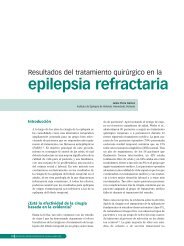
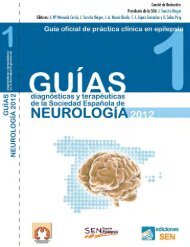
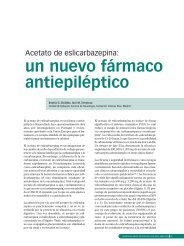
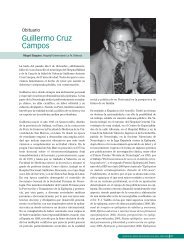
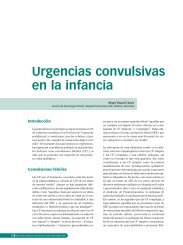

![[ ] INDICACIONES DE LA MONITORIZACIÃN VÃDEO-EEG ...](https://img.yumpu.com/39529281/1/184x260/-indicaciones-de-la-monitorizacian-vadeo-eeg-.jpg?quality=85)
